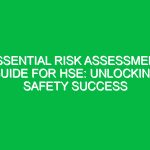Introduction
Risk assessment meaning is a fundamental concept in the Health, Safety, and Environment (HSE) domain. It encompasses the processes and methods used to identify, evaluate, and prioritize risks associated with workplace Hazards. Understanding risk assessment is essential for organizations striving to create a safe and healthy work environment while adhering to legal and ethical obligations.
In today’s fast-paced world, where businesses are constantly confronted with new challenges, effective risk assessment is more crucial than ever. This article will delve into the meaning of risk assessment in HSE, explore its key components, and provide insights into Best Practices and regulatory considerations. By the end, you will have a comprehensive understanding of risk assessment meaning and its vital role in promoting Safety and Sustainability.
Understanding Risk Assessment Meaning in HSE
Risk assessment refers to the systematic process of evaluating potential risks that could be involved in a projected activity or undertaking. Within the HSE framework, this means identifying Hazards, analyzing and evaluating the risk associated with these hazards, and determining appropriate ways to eliminate or control the risks.
To break this down further, risk assessment can be divided into several distinct stages:
1. Hazard Identification
This is the first step in the risk assessment process. Hazards can be physical, chemical, biological, ergonomic, or psychosocial. For example, a construction site may present physical hazards such as falling objects, while a laboratory might have chemical hazards from toxic substances. Identifying these hazards requires thorough observation and understanding of the work environment.
2. Risk Analysis
Once hazards are identified, the next step is to analyze the risk associated with each hazard. This involves determining the likelihood of an occurrence and the potential severity of its consequences. For instance, if a worker is exposed to a chemical spill, what is the probability of injury or health impact, and how severe could that impact be?
3. Risk Evaluation
In this stage, the risk identified during the analysis phase is compared against risk criteria. This comparison helps decide whether the risk is acceptable or if further action is necessary. It involves evaluating existing Control Measures and determining if they are sufficient to mitigate the risks.
4. Risk Control
Finally, if the risk is deemed unacceptable, control measures must be implemented. These measures can include engineering controls, administrative actions, or Personal Protective Equipment (PPE). The goal here is to reduce the risk to an acceptable level. For example, installing Safety guards on machinery can significantly lower the risk of accidents.
5. Monitoring and Review
Risk assessment is not a one-time process. Continuous monitoring and review of the risk management strategies are essential to ensure they remain effective. Changes in workplace practices, new equipment, or evolving Regulations may necessitate a reassessment of risks.
The Importance of Risk Assessment in HSE
The significance of understanding risk assessment meaning in the HSE context cannot be overstated. Here are some critical reasons why it plays a vital role in Workplace Safety:
1. Legal Compliance
Compliance with HSE regulations is mandatory for organizations. Many countries have laws requiring businesses to conduct regular risk assessments to protect workers and the environment. Failure to comply can result in severe penalties, including fines and litigation.
2. Enhanced Safety
Effective risk assessment helps prevent accidents and injuries. By identifying and addressing potential hazards before they cause harm, organizations can create a safer working environment. For instance, a manufacturing plant that regularly conducts risk assessments may reduce workplace injuries significantly.
3. Improved Productivity
A safe working environment leads to improved employee morale and productivity. Workers who feel safe and secure are likely to be more engaged and efficient. Conversely, a workplace rife with hazards can lead to increased absenteeism and a decrease in productivity.
4. Cost Savings
Investing in risk assessment can save organizations money in the long run. By preventing accidents and injuries, companies can avoid costs associated with medical expenses, legal fees, and lost productivity. For instance, a construction company that implements a robust risk assessment process may save thousands in potential claims and fines.
Best Practices for Conducting Risk Assessments
Implementing effective risk assessments requires a strategic approach. Here are some Best Practices to consider:
1. Involve Employees
Engaging employees in the risk assessment process is crucial. They often have firsthand knowledge of the hazards associated with their work. Encouraging workers to report hazards can lead to more comprehensive assessments.
2. Use a Structured Approach
Utilizing a structured method for conducting risk assessments can enhance consistency and thoroughness. Many organizations adopt standardized frameworks, such as ISO 45001, which provides guidelines for Occupational Health and safety management systems.
3. Prioritize Risks
Not all risks are created equal. Prioritizing risks based on their potential impact and likelihood of occurrence helps organizations focus their resources on the most critical hazards. This targeted approach enables more effective risk management.
4. Document Findings
Maintaining thorough documentation of the risk assessment process is essential. This documentation serves as a record of compliance and can be invaluable during audits or inspections. It also aids in reviewing and updating risk assessments over time.
Regulations and Standards Governing Risk Assessment
Understanding the legal landscape surrounding risk assessment is vital for organizations. Various regulations and standards govern how risk assessments should be conducted:
1. Occupational Safety and Health Administration (OSHA)
In the United States, osha mandates that employers provide a safe working environment. This includes conducting risk assessments to identify and mitigate hazards. OSHA regulations require employers to comply with specific standards related to Workplace Safety.
2. Health and Safety at Work Act 1974 (UK)
In the UK, the Health and Safety at Work Act requires employers to ensure, as far as reasonably practicable, the health and safety of employees. This includes conducting risk assessments and implementing necessary Control Measures.
3. International Standards Organization (ISO) 45001
ISO 45001 provides a framework for organizations to manage occupational health and safety. It emphasizes the importance of risk assessment in achieving a safe working environment. Organizations seeking certification to ISO 45001 must demonstrate effective risk management practices.
Real-Life Examples of Risk Assessment in Action
To further illustrate the importance of risk assessment meaning in the HSE context, consider the following hypothetical scenarios:
Example 1: Construction Site
Imagine a construction company that regularly conducts risk assessments. During a routine evaluation, the safety officer identifies the risk of falling objects from scaffolding. As a result, the company implements additional Safety Measures, such as installing netting and providing helmets to workers. This proactive approach minimizes the risk of injury and enhances overall safety.
Example 2: Chemical Manufacturing
In a chemical manufacturing facility, risk assessments reveal the potential for chemical spills. The company implements comprehensive Training programs for employees on spill response and invests in advanced containment systems. These actions not only protect workers but also reduce the risk of environmental contamination.
Conclusion
In conclusion, understanding risk assessment meaning is crucial for any organization operating within the HSE domain. By recognizing, analyzing, and mitigating risks, businesses can foster a culture of safety and compliance. The importance of conducting thorough risk assessments extends beyond legal obligations; it enhances safety, productivity, and overall organizational performance.
As we move forward in an increasingly complex world, organizations must prioritize risk assessment as a vital component of their health, safety, and environmental strategies. By adopting best practices and adhering to regulations, companies can unlock the full potential of risk assessment, ensuring a safer and more sustainable future for all.


